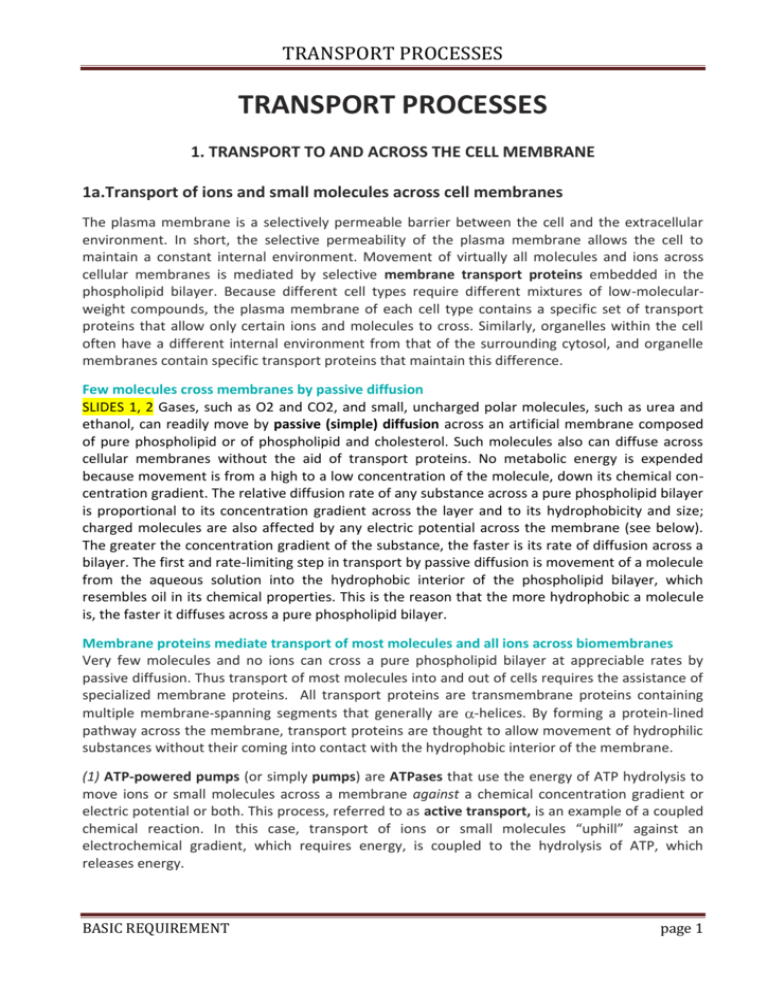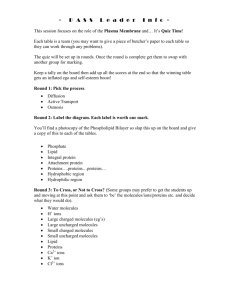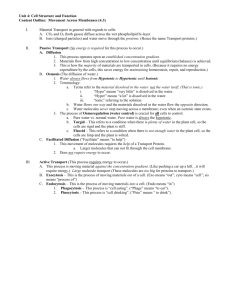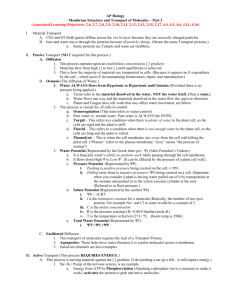TRANSPORT PROCESSES
advertisement

TRANSPORT PROCESSES TRANSPORT PROCESSES 1. TRANSPORT TO AND ACROSS THE CELL MEMBRANE 1a.Transport of ions and small molecules across cell membranes The plasma membrane is a selectively permeable barrier between the cell and the extracellular environment. In short, the selective permeability of the plasma membrane allows the cell to maintain a constant internal environment. Movement of virtually all molecules and ions across cellular membranes is mediated by selective membrane transport proteins embedded in the phospholipid bilayer. Because different cell types require different mixtures of low-molecularweight compounds, the plasma membrane of each cell type contains a specific set of transport proteins that allow only certain ions and molecules to cross. Similarly, organelles within the cell often have a different internal environment from that of the surrounding cytosol, and organelle membranes contain specific transport proteins that maintain this difference. Few molecules cross membranes by passive diffusion SLIDES 1, 2 Gases, such as O2 and CO2, and small, uncharged polar molecules, such as urea and ethanol, can readily move by passive (simple) diffusion across an artificial membrane composed of pure phospholipid or of phospholipid and cholesterol. Such molecules also can diffuse across cellular membranes without the aid of transport proteins. No metabolic energy is expended because movement is from a high to a low concentration of the molecule, down its chemical concentration gradient. The relative diffusion rate of any substance across a pure phospholipid bilayer is proportional to its concentration gradient across the layer and to its hydrophobicity and size; charged molecules are also affected by any electric potential across the membrane (see below). The greater the concentration gradient of the substance, the faster is its rate of diffusion across a bilayer. The first and rate-limiting step in transport by passive diffusion is movement of a molecule from the aqueous solution into the hydrophobic interior of the phospholipid bilayer, which resembles oil in its chemical properties. This is the reason that the more hydrophobic a molecule is, the faster it diffuses across a pure phospholipid bilayer. Membrane proteins mediate transport of most molecules and all ions across biomembranes Very few molecules and no ions can cross a pure phospholipid bilayer at appreciable rates by passive diffusion. Thus transport of most molecules into and out of cells requires the assistance of specialized membrane proteins. All transport proteins are transmembrane proteins containing multiple membrane-spanning segments that generally are -helices. By forming a protein-lined pathway across the membrane, transport proteins are thought to allow movement of hydrophilic substances without their coming into contact with the hydrophobic interior of the membrane. (1) ATP-powered pumps (or simply pumps) are ATPases that use the energy of ATP hydrolysis to move ions or small molecules across a membrane against a chemical concentration gradient or electric potential or both. This process, referred to as active transport, is an example of a coupled chemical reaction. In this case, transport of ions or small molecules “uphill” against an electrochemical gradient, which requires energy, is coupled to the hydrolysis of ATP, which releases energy. BASIC REQUIREMENT page 1 TRANSPORT PROCESSES (2) Channel proteins transport water or specific types of ions and hydrophilic small molecules down their concentration or electric potential gradients. Such protein-assisted transport sometimes is referred to as facilitated diffusion. Channel proteins form a hydrophilic passageway across the membrane through which multiple water molecules or ions move simultaneously, single file at a very rapid rate. Some ion channelsare open much of the time; these are referred to as nongated channels. Most ion channels, however, open only in response to specific chemical or electrical signals; these are referred to as gated channels. (3) Transporters (also called carriers) move a wide variety of ions and molecules across cell membranes. Three types of transporters have been identified. (a) Uniporters transport a single type of molecule down its concentration gradient via facilitated diffusion. Glucose and amino acids cross the plasma membrane into most mammalian cells with the aid of uniporters. In contrast, antiporters and symporters couple the movement of one type of ion or molecule against its concentration gradient with the movement of one or more different ions down its concentration gradient. These proteins often are called cotransporters, referring to their ability to transport two different solutes simultaneously. Like ATP pumps, cotransporters mediate coupled reactions in which an energetically unfavorable reaction (i.e., uphill movement of molecules) is coupled to an energetically favorable reaction. Note, however, that the nature of the energy-supplying reaction driving active transport by these two classes of proteins differs. ATP pumps use energy from hydrolysis of ATP, whereas cotransporters use the energy stored in an electrochemical gradient. This latter process sometimes is referred to as secondary active transport. SLIDES 3, 4 Electrochemical gradient: from Life ed. 9th SLIDE 6 Glucose transporter: from Life ed. 9th SLIDE 6 Aquaporins: water channels Water crosses cell membranes by two routes: by diffusion through the lipid bilayer and through water channels called aquaporins. Functional characterization of the first aquaporin was reported in 1992, but water channels were suspected to exist well before that time, because the osmotic permeability of some types of epithelial cells was much too large to be accounted for by simple diffusion through the plasma membrane. A single human aquaporin-1 channel facilitates water transport at a rate of roughly 3 billion water molecules per second. Such transport appears to be bidirectional, in accordance with the prevailing osmotic gradient. The classical aquaporins transport solute-free water across cell membranes; they appear to be exclusive water channels and do not permeate membranes to ions or other small molecules. Some aquaporins - known as aquaglyceroporins - transport water plus glycerol and a few other small molecules. More than 10 different mammalian aquaporins have been identified to date, and additional members are suspected to exist. Closely related water channel proteins have been isolated from plants, insects and bacteria. Aquaporin-1 from human red blood cells was the first to be discovered and is probably the best studied. Hydrophobicity plots of their amino acid sequences predict that the aquaporins have six membrane-spanning segments, as depicted in the model of aquaporin-1 to the right. Based on studies with aquaporin1, it appears that aquaporins exist in the plasma membrane as homotetramers. Each aquaporin monomer contains two hemi-pores, which fold together to form a water channel. SLIDE 7, 8 Ion channels: from Life ed. 9th SLIDE 9, 10 Active transport: from Life ed. 9th BASIC REQUIREMENT page 2








